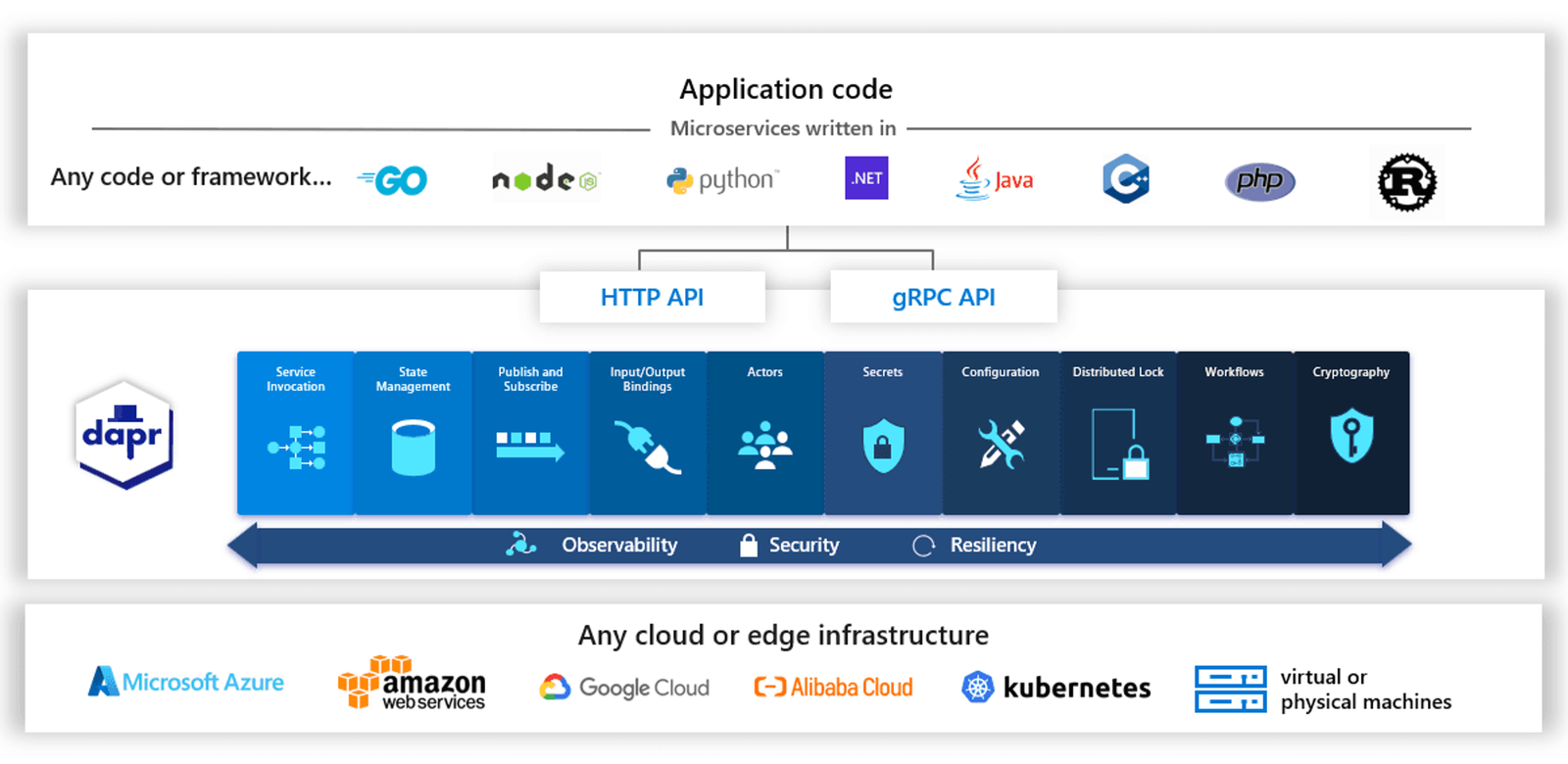Evgeny Zubkov | DevOps Engineer at Coherent Solutions Georgia
In the realm of cutting-edge Research and Development (R&D), our company's specialists, boasting profound expertise, have been actively engaging in discussions on topics crucial to contemporary business landscapes.
This article draws its inspiration from the insightful presentations and discussions led by Pavel Nikiforov, an experienced DevOps Engineer, Vitaly Skuratovich, Deputy DevOps Practice Lead for Technology, and Alexander Simonov, Deputy DevOps Practice Lead. Their collaborative efforts, particularly evident in the “WHOIS DevOps Tech Talks”, have been instrumental in elucidating the nuances and strategic importance of Dapr (Distributed Application Runtime) in modern microservices architecture and application development. Their combined perspectives and deep dive into Dapr’s role in enhancing and safeguarding IT infrastructure have significantly shaped the content and depth of this piece.
Introduction
In the evolving landscape of software development, microservices architecture has emerged as a paradigm shift, emphasizing modularity and scalability. This architecture breaks down applications into smaller, independent services, each running in its own process and communicating with lightweight mechanisms, often an HTTP resource API. This granular approach offers several advantages, including improved scalability, flexibility, and the ability to use different technologies for different services. However, it also introduces complexities in areas like inter-service communication, state management, and resilience.
Enter Dapr (Distributed Application Runtime), an open-source, event-driven runtime that simplifies building resilient, microservices-based applications. Dapr offers a platform-agnostic, language-independent framework that provides a suite of distributed system capabilities embedded in a sidecar architecture. This approach allows developers to focus on the core business logic of their applications, abstracting away the intricacies of building a distributed system.

The importance of Dapr in modern application development cannot be overstated. As organizations shift towards cloud-native technologies and embrace microservices, the need for tools that can mitigate the associated complexities becomes critical. Dapr not only addresses these challenges but also enhances productivity and application resilience. It is designed to seamlessly integrate into any development environment, from local development machines to large-scale, cloud-native environments.
Dapr Overview
Dapr, an acronym for Distributed Application Runtime, is an innovative tool that has been specifically designed to tackle the complexities of building modern, distributed applications, particularly those following a microservices architecture. At its core, Dapr is a portable, event-driven runtime that offers a rich set of building blocks for various aspects of distributed systems, including state management, service-to-service invocation, and pub/sub messaging.

One of the defining features of Dapr is its use of the sidecar architecture model. In this model, each microservice is accompanied by a Dapr sidecar - a separate, lightweight process that runs alongside the microservice. This sidecar acts as an intermediary, handling tasks such as communication, state management, and event handling. The sidecar architecture is crucial for several reasons:
-
Decoupling: It separates the concerns of application logic and infrastructure services, promoting a clear separation of concerns.
-
Uniformity: Regardless of the programming language or framework used for the microservices, the sidecar provides a consistent set of capabilities across all services.
-
Ease of Use: Developers interact with the DAPR sidecars via HTTP, gRPC, making it straightforward to integrate Dapr into existing applications.
-
Resilience: The sidecar model inherently promotes resilience and reliability in microservices, as it handles inter-service communication and other distributed systems challenges efficiently.
Key Features of Dapr
Dapr stands out in the landscape of cloud-native development due to its unique features and capabilities, especially designed to ease the complexities of building and managing microservices-based applications. Here’s a detailed look at some of its key features:

-
Building Blocks: Dapr provides a collection of building blocks, each addressing a specific aspect of distributed systems and microservices architecture.
-
Platform Agnosticism: Dapr is designed to run on various platforms, making it highly versatile.
a. Kubernetes Integration: It integrates seamlessly with Kubernetes, offering features like automated sidecar injection, making it a natural fit for cloud-native applications.
b. Edge and Hybrid Cloud Environments: Dapr is also suitable for edge computing scenarios and hybrid cloud environments, providing the same set of capabilities and consistency across different deployment scenarios.
-
Language Independence: One of Dapr’s most significant advantages is its language-agnostic approach.
In summary, Dapr’s comprehensive suite of building blocks, platform-agnostic nature, and language independence collectively simplify the development and management of distributed, microservices-based applications. These features enable developers to build scalable, resilient, and maintainable applications while focusing on business logic rather than the complexities of the underlying infrastructure.
Pros and Cons of Dapr
While Dapr offers numerous advantages in the realm of microservices and distributed systems, it is also essential to consider its potential drawbacks. Here’s a balanced view of its pros and cons:
Advantages:
-
Simplified Development: Dapr abstracts complex aspects of microservices development, such as inter-service communication and state management, simplifying the development process. This allows developers to focus on business logic rather than infrastructural concerns.
-
Cross-Platform Support: Being platform-agnostic, Dapr can be used across various environments like Kubernetes, edge computing, and hybrid cloud setups. This flexibility is crucial for organizations that operate in multi-platform environments.
-
Built-in Features for Resilience: Dapr’s sidecar model and its built-in functionalities like state management, pub/sub messaging, and resource bindings enhance the resilience and reliability of applications. It inherently supports patterns essential for fault tolerance and high availability.
-
Community and Ecosystem Support: The strong open-source community around Dapr contributes to its continuous improvement, offering a rich ecosystem of tools and integrations.
-
Language Independence: Dapr supports multiple programming languages, making it accessible to a wide range of development teams and allowing for integration into existing codebases with minimal friction.
Disadvantages:
-
Learning Curve: Despite its aim to simplify development, Dapr introduces new concepts and components that developers need to understand. This learning curve can be a hurdle, especially for teams not familiar with cloud-native and microservices architectures.
-
Potential Overhead: The sidecar architecture, while beneficial, can introduce additional resources overhead. Each microservice with a Dapr sidecar consumes more CPU and memory compared to a standalone service, which could be a concern in resource-constrained environments.
-
Limitations in Certain Scenarios: While Dapr is highly versatile, there may be scenarios where its model doesn’t fit perfectly. For instance, in highly optimized or specialized environments, the abstraction provided by Dapr might limit fine-grained control over certain aspects of the system.
To sum up, Dapr presents a compelling solution for many of the challenges in building and managing microservices, offering a range of features that enhance developer productivity and application resilience. However, organizations must consider the potential overhead and the learning curve associated with its adoption, ensuring that it aligns well with their specific use cases and infrastructure.
Practical Considerations
When incorporating Dapr into your development workflow, it’s crucial to understand when and how it fits best, how it compares to other tools, and the best practices for its implementation.

When to Use Dapr:
1.Complex Microservices Architectures: Dapr shines in environments where there’s a need to simplify complex interactions between numerous microservices. It’s particularly beneficial when dealing with challenges in communication, state management, and event-driven architectures.
2. Multi-language, Multi-platform Scenarios: If your development environment involves multiple programming languages and needs to be deployed across different platforms (like Kubernetes, cloud, and edge environments), Dapr’s language-agnostic and platform-agnostic nature makes it an ideal choice.
3. Need for Scalability and Resilience: In applications where scalability and resilience are critical, Dapr’s built-in features for state management, pub/sub messaging, and service invocation can significantly enhance these aspects.
Comparison with Other Tools:

-
Service Meshes like Istio: Unlike service meshes that primarily focus on networking concerns, Dapr provides additional capabilities like state management and resource bindings. While both offer service-to-service communication, Dapr extends its functionalities to cater to a broader range of application development needs.
-
Function as a Service (FaaS) Platforms: Dapr complements FaaS platforms by providing a consistent runtime for state management and inter-service communication, which can sometimes be limitations in FaaS environments.
Best Practices for Implementing DAPR:
-
Start Small: Gradually integrate Dapr into your existing system, perhaps starting with non-critical services. This approach helps in understanding Dapr’s impact and tuning it as per your system’s needs.
-
Leverage Dapr Building Blocks Judiciously: Evaluate which Dapr capabilities (like state management or pub/sub) are most beneficial for your application and implement them where they add the most value.
-
Monitor and Optimize: Use Dapr’s observability features to monitor its impact on your system. Pay attention to resource usage and performance, optimizing as needed.
-
Stay Updated with Community Developments: Regularly engage with the Dapr community. Staying updated with the latest improvements and best practices from the community can be invaluable.
Conclusion
Dapr has firmly established its significance in the microservices landscape, emerging as a key player in simplifying the complexities inherent in distributed systems. Its comprehensive suite of building blocks, such as service invocation, state management, and pub/sub messaging, addresses critical aspects of microservices architectures. The sidecar architecture, platform agnosticism, and language independence further enhance its appeal, making it a versatile choice for a wide range of development environments.
Adopting Dapr in modern application development can be a strategic move, especially for organizations navigating the intricacies of cloud-native technologies and microservices. It offers a streamlined pathway to build scalable, resilient, and maintainable applications, allowing developers to focus on business logic rather than infrastructural challenges. However, it’s essential to weigh its advantages against potential overheads and the learning curve involved. In summary, Dapr represents a significant advancement in the microservices domain, offering a robust, flexible, and developer-friendly platform that is well-suited to the demands of modern application development.
FAQ
-
Dapr is platform-agnostic, meaning it can be deployed across various environments including Kubernetes, cloud, and edge computing platforms. This flexibility enables consistent application development and management regardless of the underlying infrastructure.
-
Yes, Dapr is language-independent. It offers SDKs for popular languages such as Python, Java, .NET, and more, allowing developers to work with their preferred language while leveraging Dapr’s functionalities.
-
Some of the drawbacks include the learning curve associated with understanding Dapr’s concepts and components, potential resource overhead due to the sidecar architecture, and possible limitations in highly optimized or specialized environments where Dapr’s abstractions might not fit perfectly.
-
Dapr is designed to integrate seamlessly with both existing microservices architectures and new applications. Its sidecar model and standardized APIs allow for easy incorporation into existing systems without significant code changes.
-
Key best practices include starting with a small, non-critical part of your system to understand Dapr’s impact, judiciously using Dapr’s building blocks where they add the most value, monitoring resource usage and performance, and staying updated with the latest developments from the Dapr community.
-
Dapr provides state management capabilities that enable services to easily save, query, and delete state data. It abstracts the complexities of working directly with databases, offering a consistent API to interact with various state stores, which simplifies state management in a distributed system.



